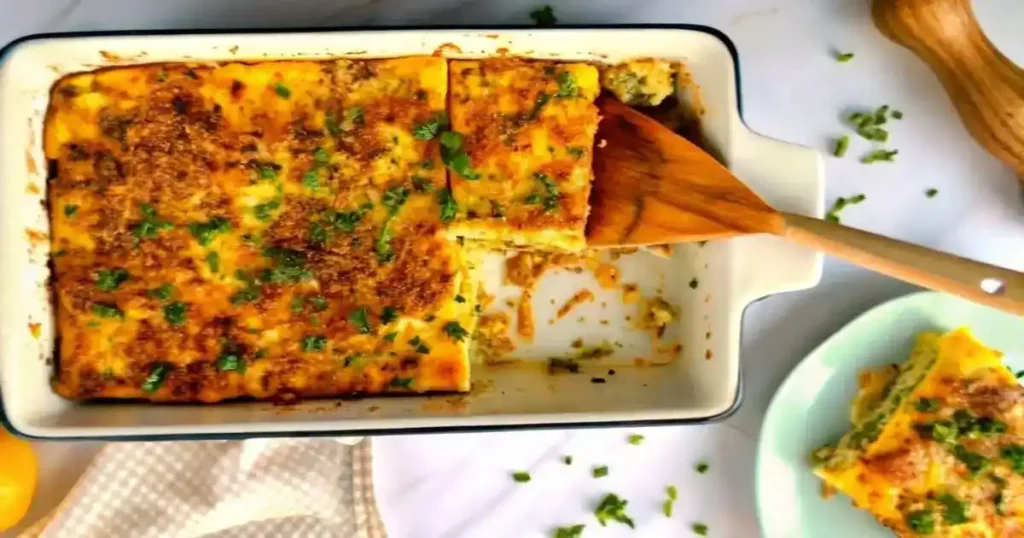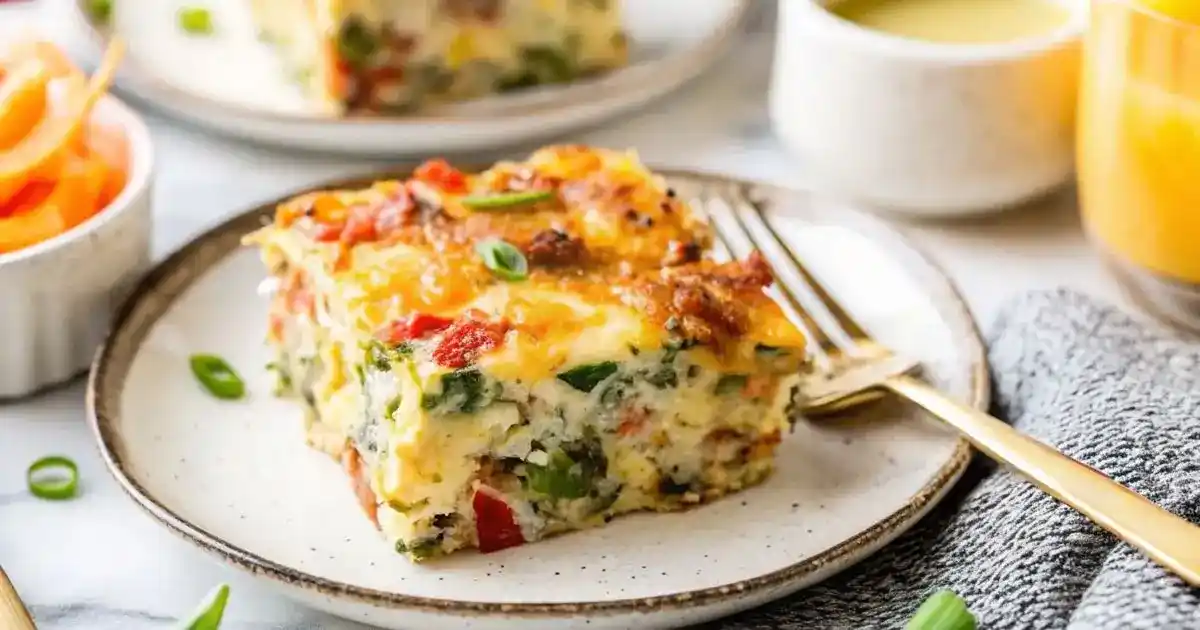Baked Cottage Cheese Eggs
Table of Contents
Introduction
If you’re aiming to start your day with a meal that’s both satisfying and nutritious, baked cottage cheese eggs might be your new go-to. This dish combines the creamy texture of cottage cheese with the rich flavor of eggs, resulting in a breakfast that’s not only tasty but also packed with protein. Incorporating cottage cheese into your eggs can significantly boost the protein content of your meal. For instance, adding cottage cheese to egg muffins can raise the protein content from 6 grams to 16 grams per muffin, helping you stay fuller longer and meet your daily protein needs.
Moreover, cottage cheese is a versatile ingredient that’s low in carbohydrates and rich in essential nutrients like calcium. It’s an excellent choice for those following high-protein or low-carb diets. Baked cottage cheese eggs are not only nutritious but also convenient. They can be prepared in advance, stored in the refrigerator or freezer, and reheated quickly, making them ideal for busy mornings.
In this blog post, we’ll explore the benefits of baked cottage cheese eggs, provide a step-by-step recipe, and offer tips for meal prep and storage. Let’s dive in and discover how this simple dish can transform your breakfast routine!
Ingredients & Nutritional Information
Essential Ingredients
To prepare a delicious and nutritious baked cottage cheese egg dish, you’ll need the following core ingredients:
- Cottage Cheese: Provides creaminess and a high protein content.
- Eggs: Serve as the primary protein source and binding agent.
- Spinach: Adds fiber, nutrients, and bright color.
- Cheddar Cheese: Offers a rich, savory flavor.
- Salt & Pepper: Enhances overall taste.
Optional Add-ins
Mix and match these optional add-ins to make your egg bake just the way you like it.
- Broccoli: Introduces a crunchy texture and additional nutrients.
- Mushrooms: Add a rich, earthy taste and hearty texture.
- Mozzarella or Parmesan Cheese: Provides different flavor profiles and melt characteristics.
- Bell Peppers: Add sweetness and a pop of color.
- Onions: Impart a subtle sweetness and depth of flavor.
Nutritional Breakdown (Per Serving)
Here’s an approximate breakdown per serving:
- Calories: Approximately 129 kcal
- Protein: Approximately 12.5 grams
- Fat: Approximately 8 grams
- Carbohydrates: Approximately 4 grams
These values make baked cottage cheese eggs an excellent choice for a high-protein, low-carbohydrate meal, suitable for breakfast or meal prep.
Kitchen Tools & Utensils
Required Tools
To prepare baked cottage cheese eggs, the following kitchen tools are essential:
- Mixing Bowls: For combining ingredients.
- Whisk: To beat eggs and mix ingredients thoroughly.
- Baking Dish: A standard 9×13-inch dish works well for casseroles.
- Measuring Cups and Spoons: To ensure precise ingredient quantities.
- Oven: Preheated to the required temperature.
Optional Tools
For added convenience or variations of the recipe, consider these optional tools:
- Muffin Tins: Ideal for making individual egg muffins.
- Blender or Food Processor: To achieve a smoother mixture if desired.
- Silicone Spatula: Useful for scraping down bowls and ensuring all ingredients are incorporated.
- Cooling Rack: Allows the baked dish to cool evenly after removal from the oven.
Having these tools on hand will streamline the cooking process and help achieve the best results for your baked cottage cheese eggs.
Step-by-Step Cooking Instructions
1. Preheat the Oven
Begin by setting your oven to 375°F (190°C) to ensure it’s at the right temperature when you’re ready to bake.
2. Prepare the Baking Dish
Lightly grease a 9×13-inch baking dish with cooking spray or a small amount of butter to prevent sticking and facilitate easy cleanup.
3. Sauté Vegetables (Optional)
If you’re adding vegetables like onions, bell peppers, or mushrooms, sauté them in a skillet over medium heat until they’re softened. This step enhances their flavor and ensures they cook evenly in the bake.
4. Mix the Wet Ingredients
In a large mixing bowl, crack the eggs and whisk thoroughly until the yolks and whites are fully blended. Add cottage cheese, milk, salt, pepper, and any preferred spices or herbs. Continue whisking until the mixture is smooth and evenly combined.
5. Incorporate Add-ins
Fold in the sautéed vegetables and shredded cheese (such as cheddar, mozzarella, or parmesan) into the egg mixture, ensuring even distribution throughout.
6. Transfer to Baking Dish
Pour the mix into the greased dish and spread it out evenly with a spatula so it cooks evenly.
7. Bake the Casserole
Place the dish in the preheated oven and bake for 35–45 minutes, or until the top is golden brown and a knife inserted into the center comes out clean, indicating the eggs are fully set.
8. Rest Before Serving
Once baked, remove the casserole from the oven and allow it to rest for about 10 minutes.
9. Serving Suggestions
Serve warm, garnished with fresh herbs like chives or parsley. Pair with a side salad, fresh fruit, or whole-grain toast for a balanced meal
10. Storage and Reheating
Refrigerate any leftovers in an airtight container and consume within 4 days. To reheat, warm individual portions in the microwave for 1–2 minutes or until heated through.
Serving Suggestions & Variations
Serving Ideas
Baked cottage cheese eggs are versatile and can be enjoyed in various ways:
- Toast or English Muffins: Serve slices atop whole-grain toast or English muffins for a hearty breakfast.
- Tortilla Wraps: Wrap portions in whole wheat or gluten-free tortillas for a portable meal.
- Fresh Fruit: Pair with a side of fresh fruit like berries or melon for a balanced plate.
- Salads: Serve alongside a crisp green salad for a light lunch option.
- Breakfast Sides: Complement with sides like roasted potatoes or avocado slices.
Dietary Variations
Adapt the recipe to suit various dietary needs:
- Vegetarian: The base recipe is vegetarian-friendly. Enhance it with additional vegetables like bell peppers or mushrooms.
- Gluten-Free: Ensure all added ingredients, such as tortillas or sides, are gluten-free to maintain a gluten-free meal.
- Low-Carb/Keto: Omit high-carb sides and focus on low-carb vegetables like spinach or zucchini.
- Dairy-Free: Substitute cottage cheese with dairy-free alternatives and use plant-based cheeses.
Flavor Enhancements
Elevate the taste profile with these additions:
- Herbs: Incorporate fresh herbs like parsley, chives, or basil for added freshness.
- Spices: Add spices such as paprika, garlic powder, or chili flakes to introduce depth and heat.
- Cheese Varieties: Experiment with different cheeses like mozzarella, feta, or goat cheese for varied flavors.
- Vegetables: Include sautéed onions, roasted red peppers, or sun-dried tomatoes for additional texture and taste.
- Sauces: Drizzle with salsa, hot sauce, or pesto to enhance the overall flavor.
These suggestions allow you to customize the baked cottage cheese eggs to your preference, making them a versatile option for any meal.

Storage, Reheating, and Meal Prep Tips
Storing Leftovers
To ensure your baked cottage cheese eggs remain fresh:
- Refrigeration: Store any remaining portions in an airtight container in the refrigerator for 3 to 4 days.
- Freezing: Want to save it for later? Just freeze the casserole—wrap it up tight with plastic wrap and foil or use a freezer-safe container. Don’t forget to label it! It’ll keep for 2 to 3 months
Reheating Instructions
To enjoy your leftovers safely and deliciously:
- Oven Method: Preheat your oven to 350°F (177°C). Cover the casserole with foil to retain moisture. Reheat for 20–30 minutes if refrigerated, or 50–60 minutes if frozen, until the internal temperature reaches 165°F (74°C).
- Microwave Method: Place individual servings on a microwave-safe plate. Loosely cover it and microwave on high for 1–2 minutes, checking every 30 seconds so it heats evenly.
Meal Prep Tips
For convenient, ready-to-eat meals:
- Batch Cooking: Prepare the casserole in advance and store it in individual portions. “That way, you can just reheat it whenever you need during the week.”
- Freezing Portions: Let the casserole cool all the way after baking. Then cut it into single servings, wrap them up well, and freeze. They’ll keep for up to two months. Just thaw in the fridge overnight before reheating.
- Labeling: Clearly label each portion with the date and reheating instructions to maintain freshness and safety.
These storage, reheating, and meal prep strategies will help you enjoy your baked cottage cheese eggs at their best, whether you’re planning ahead or enjoying leftovers.
Jump to Recipe

baked cottage cheese eggs
Equipment
- 9×13-inch baking dish
- Skillet
- Large mixing bowl
- Whisk
- Knife and cutting board
- Measuring cups and spoons
Ingredients
- 12 large eggs
- 1 cup full-fat cottage cheese
- 1 cup shredded cheddar cheese
- 1 cup fresh spinach chopped
- 1/2 cup diced bell pepper
- 1/2 cup diced onion
- Salt and pepper to taste
Instructions
- Preheat the Oven: Set your oven to 375°F (190°C).
- Prepare the Baking Dish: Grease a 9×13-inch baking dish with cooking spray or butter.
- Sauté Vegetables: In a skillet, sauté the diced bell pepper and onion over medium heat until softened, about 5 minutes.
- Mix Wet Ingredients: In a large bowl, whisk together the eggs, cottage cheese, and shredded cheddar cheese until well combined.
- Add Vegetables and Seasoning: Stir in the sautéed vegetables, chopped spinach, salt, and pepper.
- Transfer to Baking Dish: Pour the mixture into the prepared baking dish, spreading it evenly.
- Bake: Place in the preheated oven and bake for 35–45 minutes, or until the top is golden brown and a knife inserted into the center comes out clean.
- Cool and Serve: Allow the casserole to cool for 10 minutes before slicing and serving.
Notes
- Storage: Store leftovers in an airtight container in the refrigerator for up to 4 days.
- Reheating: Reheat individual portions in the microwave for 1–2 minutes or until heated through.
- Make-Ahead: Assemble the casserole the night before, cover, and refrigerate. Bake the next morning as directed.
- Customization: Feel free to add other vegetables like mushrooms or zucchini, or switch up the cheese to suit your taste.
Frequently Asked Questions (FAQ)
What does adding cottage cheese to eggs do?
Incorporating cottage cheese into eggs enhances their creaminess and boosts protein content without adding excessive fat. The curds soften during cooking, blending seamlessly into the eggs for a rich, fluffy texture.
How do I make baked cottage cheese eggs?
To prepare baked cottage cheese eggs, whisk together eggs, cottage cheese, and seasonings. Pour the mixture into a greased baking dish and bake at 375°F (190°C) until set, approximately 20–30 minutes.
Does cottage cheese melt when baked?
Cottage cheese doesn’t melt like other cheeses due to its curd structure and low fat content. Instead of becoming gooey, it softens and blends into dishes, adding creaminess without a stretchy texture.
Can you cook cottage cheese in the oven?
Yes, you can bake with cottage cheese. When included in baked dishes, it adds a creamy texture and a protein boost, especially when combined with ingredients like eggs and vegetables .
Is baked cottage cheese good for you?
Absolutely. Cottage cheese is low in calories and high in protein, making it beneficial for muscle repair and weight management. It’s also rich in calcium and B vitamins, supporting bone health and immune function.
Are baked eggs healthy?
Yes, baked eggs are a nutritious option. They provide high-quality protein, essential vitamins, and minerals. Baking eggs retains their nutrients, offering a heart-healthy alternative to frying.
Conclusion
Baked cottage cheese eggs are more than just a delicious breakfast—they’re a powerhouse of nutrition and convenience. This dish combines the high-protein benefits of eggs and cottage cheese, making it an excellent choice for those looking to build muscle, manage weight, or maintain steady energy levels throughout the day. With approximately 20 grams of protein per serving, it’s a satisfying option that keeps you full longer than many traditional breakfast foods.
Beyond their nutritional value, baked cottage cheese eggs are incredibly versatile. Feel free to mix in whatever veggies, cheeses, or spices you like to make it your own. Whether you prefer a classic combination of spinach and cheddar or a more adventurous mix with mushrooms and bell peppers, the possibilities are endless.
Meal prepping this dish is a breeze. Prepare a batch in advance, and you’ll have a ready-to-eat, high-protein meal waiting for you throughout the week. It’s perfect for busy mornings or as a quick lunch option.
We encourage you to give this recipe a try and explore the various variations you can create. Don’t hesitate to share your unique twists or experiences with us—we’d love to hear how you make this dish your own!
Similar Recipes
- Cottage Cheese Eggs : Delicious and Easy to Make
- Cottage Cheese Egg Bake: How to Make It Extra Fluffy
- cottage cheese egg salad How to master creamy texture
Have you given our recipe a try ?
Last Updated on October 1, 2025 by Janelle
- Cream Cheese Pasta Sauce (Better Than Alfredo in 15 Minutes) - November 29, 2025
- The Only Chicken Mac and Cheese Recipe You’ll Ever Need - November 15, 2025
- The Best Homemade Cheeseburger Macaroni Recipe - November 1, 2025

